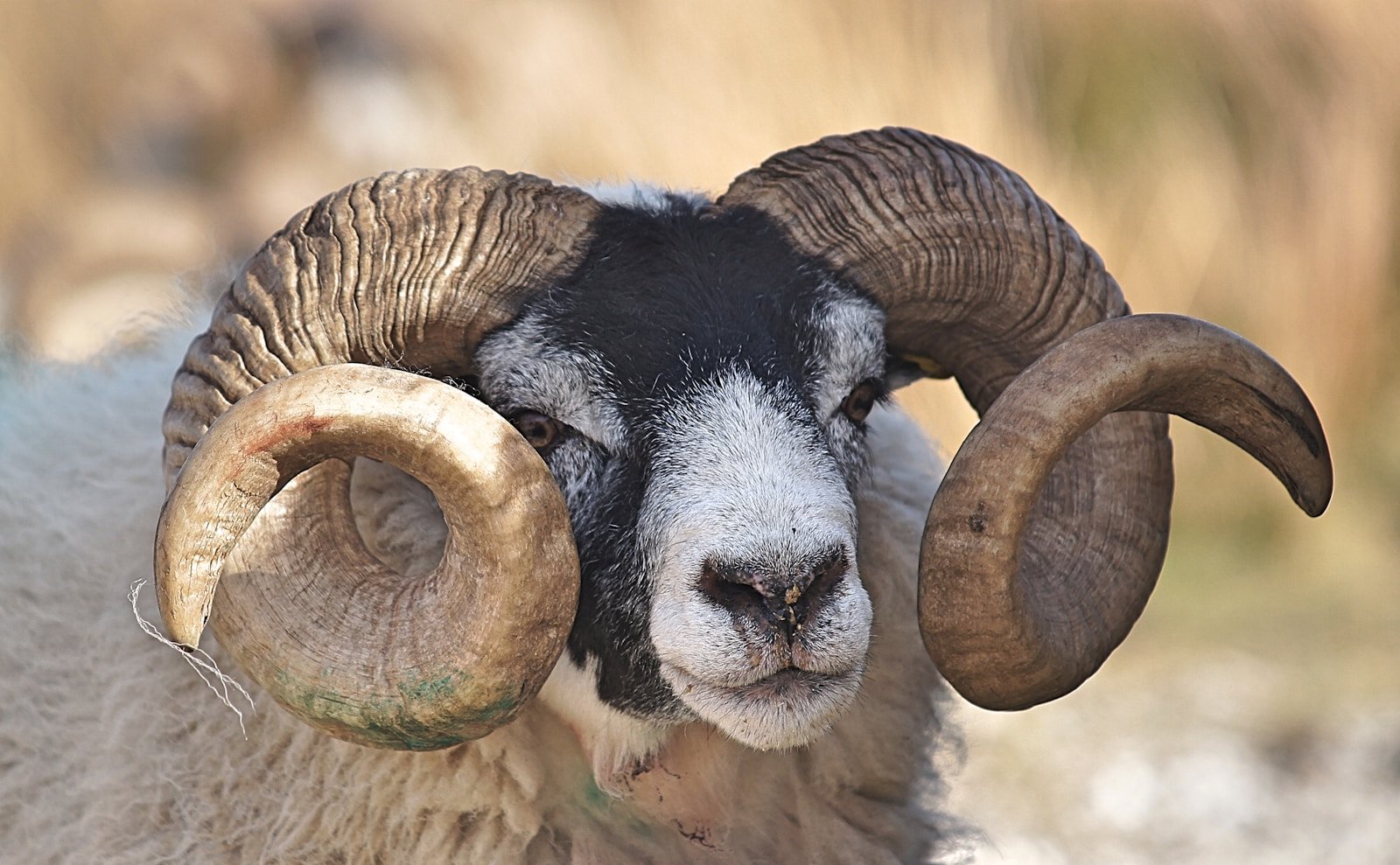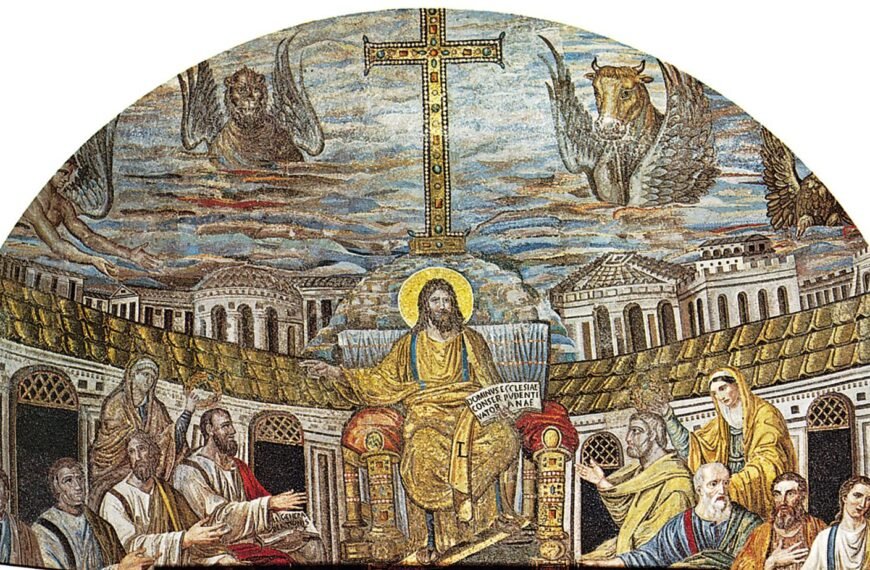The ram in the Bible is more than just an animal. It has deep spiritual meaning and stands for many themes and ideas. Have you ever thought about what does a ram symbolize in the bible?? It relates to sacrifice, strength, and God’s help.
A famous story with a ram is about Abraham and Isaac. In this story, the ram takes Isaac’s place in a sacrifice. This shows the idea of substitution and making up for sins. It also hints at Christ’s sacrifice for us, showing how substitution and making up for sins is important in the Bible.
The ram is also linked to strength and power. In the Bible, it stands for military strength, like the kings of Media and Persia in Daniel. The ram’s sacrifice in stories like Abraham’s shows its role as a symbol of strength and loyalty.
But the ram’s meaning goes beyond that. Dreams about a ram in the Bible mean leadership, authority, determination, and sacrifice. These are qualities that many people value today. To understand these dreams, we need to look at the symbolism, context, and what the dreamer feels.
The ram is a key figure in biblical stories, from tales of sacrifice and God’s help to dreams and symbols. Let’s explore more about the ram’s meaning in the Bible. We’ll look at its link to historical events, its role in sacrifice, its cultural and mythological importance, and more.
The Ram’s Symbolic Connection to Antiochus Epiphanes
In the Book of Daniel, Chapter 8, Daniel had a vision of a ram with two horns. This vision is key to understanding the Medo-Persian Empire and its link to Antiochus Epiphanes.
The ram symbolizes the kings of Persia, who ruled with great power. The two horns stand for the empire’s strong leaders.
Then, a goat with one horn destroyed the ram. This goat represents the Greek kings, especially Alexander the Great and his followers. It shows the Medo-Persian Empire’s downfall by the Greeks.
This vision helps us see how the ram relates to Antiochus Epiphanes. Antiochus was a Greek king who ruled the Seleucid Empire in the 2nd century BCE. He was crucial in Jewish history.
Antiochus was harsh on the Jewish people. He banned their customs, circumcision, and even the Sabbath. His actions led to a rebellion and the Jews taking back Jerusalem and the Temple in 164 BCE, led by Judas Maccabeus.
The ram and goat symbols in Daniel’s vision tell us about the Medo-Persian Empire’s rise and fall. They show how Alexander the Great and his successors defeated the empire. This also points out the hard times the Jewish people went through under Antiochus.
Looking deeper into the Book of Daniel, we see how history, symbols, and cosmic themes are connected. The ram and goat visions not only show the rise and fall of empires. They also shed light on the Jewish people’s struggles under Antiochus Epiphanes.

Rams in Other Biblical Chapters (Daniel 7, Daniel 2)
In the book of Daniel, rams symbolize powerful kingdoms and empires. This is clear in Daniel 7 and Daniel 2. These chapters show us the strength and power of kingdoms through the ram’s image.
In Daniel 8:3-4, a ram with two horns appears. This ram stands for the “kings of Media and Persia.” The two horns show the Medo-Persian Empire’s dual nature. The higher horn means Persia was more powerful than Media.
Persia was indeed the stronger part of the Medo-Persian Empire. This fact matches the ram’s horn symbolism, showing power and dominance.
Then, Daniel 8:5-7 talks about a goat that represents Greece. This goat shows how Greece conquered and defeated the Medo-Persian Empire. The ram’s power was broken, ending Media and Persia’s rule.
After Alexander the Great died, his kingdom split into four smaller parts. These included Greece, Macedonia, Asia Minor, Egypt, Palestine, Syria, Babylonia, and India. This split changed the balance of power in the region.
The ram’s symbolism also appears in Daniel 7. There, ten horns represent ten kings. These kings symbolize various kingdoms and empires, like the Roman Empire. The horns show political power and authority, highlighting the ram’s role in earthly dominion.
In summary, rams in Daniel 7 and Daniel 2 symbolize powerful kingdoms and empires. They show strength, dominance, and conquest. This helps us understand ancient civilizations and their symbols of power.
Rams as Sacrificial Animals and Symbols of Atonement
Rams have been important in many cultures, often used in rituals to make amends. In the Bible, they were key in religious ceremonies. They were seen as a way to ask for forgiveness, to purify, and to make things right with the divine.
In ancient Mesopotamia, rams were linked to gods because of their strength and might. In places like Ancient Egypt, Rome, and Greece, they were seen as symbols of fertility, divinity, and power.
The story of Abraham and Isaac shows how the ram was crucial in the Bible. It was a substitute for sacrifice, showing the themes of sacrifice and redemption. This story hints at Christ’s future act of redemption in Christianity.
Rams were often used in rituals for atonement, meaning to purify and make things right. They were given as burnt offerings, peace offerings, and trespass offerings. A trespass offering was for making things right after doing something wrong against God or something that belongs to him.
The ram symbolizes strength, power, sacrifice, and redemption in the Bible. Its role in atonement shows how important it is to seek forgiveness and make things right with God through sacrifices.
Rams as Symbols of Strength, Power, and Leadership
In the Bible, rams stand for strength, power, and leadership. They show the might and rule of leaders, talking about dominance, safety, and beating challenges. The ram’s strong looks and leading role make it a strong symbol of authority in the Bible.
The book of Daniel talks about the ram as a sign of strength and power. It shows the ram with two horns as a symbol of the Medo-Persian Empire’s strength and leadership.
Understanding the ram’s symbolism helps us get deeper into faith and theology. The ram stands for sacrifice, following, and faith in God. It’s a strong symbol of God’s help, blessings, and support in hard times.
Biblical verses like Genesis 22:13, Exodus 29, and Leviticus 5 talk about rams in sacrifices and military symbols. These verses show how important the ram is as a symbol of strength, power, and leadership in stories from the Bible.
Outside the Bible, rams are linked with authority, kingship, wealth, and protection in Celtic myths. In African symbolism, the ram means strength, power, might, and humility.
The symbolism of the ram tells us to trust in God’s timing and depend on His help and protection. It shows the value of strong leadership and beating challenges with faith and obedience.
Rams in Dreams and their Interpretations
Rams in dreams are full of deep meaning. They show us our inner thoughts and feelings. To understand these dreams, we need to know the dreamer’s culture and personal life. Dreams about rams often talk about being determined, bold, and ready to face challenges head-on.
Seeing a ram push through tough terrain in a dream tells us to keep going and stay true to ourselves. These dreams push us to be strong in our beliefs. They remind us to keep pushing forward, no matter what, to reach our goals.
Rams in dreams can also mean taking charge and being a leader. Like how rams are bold and lead the way, these dreams tell us to be confident and take control in certain situations. They encourage us to step up and lead in our lives or at work.
In the Bible, rams are important symbols. They stand for leadership and giving up something big for a greater cause. The story of Abraham and Isaac shows how a ram was a sign of sacrifice and God’s help. In old times, rams were seen as both food and symbols of power.
The horn of a ram, called a shofar, was used for important events. It could call people together or signal big changes. This adds to the meaning of ram dreams, showing the need to gather our strength and make big decisions.
Stories in the Bible, like the binding of Isaac and Daniel’s vision, show how rams symbolize many things. They remind us that dreams about rams talk about leadership, strength, giving up, and even about big groups in the Bible.
To understand ram dreams, we need to look at the whole situation. While they often mean being determined and bold, the exact message can change based on the dreamer’s life and situation. By thinking about the rams in our dreams, we can learn a lot about our own strength, boldness, and leadership skills.
Rams in Cultural and Mythological Contexts
Rams are important symbols in many cultures and myths. In Greek stories, rams were key characters with big roles. The story of the Golden Fleece is famous, where a ram with golden wool helped Jason and his friends on their journey. This story shows how rams are seen as symbols of power, safety, and bravery.
Rams mean different things in various cultures and religions. In ancient Egypt, the ram-headed god Amun-Ra was the king of gods, symbolizing fertility and strength. In Norse tales, the ram Heidrun was said to make endless mead, a drink of strength and energy.
Rams also stand for cultural values. In some places, they’re seen as leaders, showing courage, hard work, and willpower. For example, in Chinese culture, the ram is one of the 12 zodiac animals, meaning ambition, creativity, and wealth.
In religious stories, rams are often used as symbols of sacrifice and making things right. In ancient Judaism, rams were sacrificed to make up for sins and ask for God’s forgiveness. This idea is similar to the Christian view of Jesus as the Lamb of God, showing his sinless and perfect nature.
Overall, rams are seen as symbols of strength, power, and life in many cultures and myths. Their presence in art, stories, and religious symbols shows their deep cultural and mythological meanings.
Rams in Religious Iconography and Art
Rams have a big role in religious art and symbolism. They stand for spiritual power, authority, and artistic expression. Artists have used ram images in paintings, sculptures, and designs to share deep faith and devotion.
Rams in art often mean strength, sacrifice, and divine help. They show the power to push through and achieve great things. This shows strength in creative ways.
The spiral shape of the ram’s horn adds to its meaning. It stands for creativity and forces of spring, seen in myths. In the Vedas, rams link to Agni, the fire god, showing their spiritual power.
Rams have also been linked to the Golden Fleece and the Horn of Plenty. These symbols tie them to wealth, good fortune, and divine favors. This makes them key in religious art.
Battering rams were used to break down enemy walls. They symbolize both physical strength and the creative force needed to change things or get past hurdles. In art, this shows the ram’s power extends beyond just being physical.
The ram’s link to sacrifice is strong in religious art. Offering a ram shows deep devotion and giving up for higher goals. This act deepens the ram’s symbolism and ties it to spiritual practices.
In many cultures, the ram is an icon for action and heroism. Its presence in art inspires, gives courage, and reminds believers of qualities to aim for in their spiritual path.
From ancient times to now, the ram’s symbolism in art still moves and touches people around the world. Through sculptures and paintings, rams show spiritual importance, strength, and devotion. They leave a mark that lasts across time and cultures.
Overall Symbolism and Meaning of Rams in the Bible
Rams in the Bible are deeply meaningful, filled with symbolism. They show God’s care and mercy through stories. For example, in the story of Abraham and Isaac, God provided a ram as a substitute sacrifice. This story shows the ram as a symbol of God’s help and saving grace.
The ram also stands for leadership and strength, linked to the Hebrew letter “Aleph”. It’s often tied to burnt offerings, showing atonement and deep faith. The ram’s meaning goes beyond this, highlighting sacrifice, obedience, and giving up something precious for a greater goal.
When used in peace offerings, the ram means reconciliation and peace between God and the person offering it. In the Bible, the ram is a strong symbol, like in the Book of Daniel. There, it stands for the powerful kings of Media and Persia, showing their might and rule.
Other animals like lambs and bulls also have symbolic roles in the Bible, each with their own meanings. The presence of the ram in these stories adds to its symbolic value and cultural importance. This deepens our understanding of its role in conveying divine messages through these stories.
FAQ
What Does A Ram Symbolize In The Bible?
In the Bible, a ram stands for sacrifice, devotion, and God’s intervention. It shows obedience, faith, and trust in God. Rams also symbolize strength, power, and military might.
They are linked to leadership, authority, and overcoming challenges.
What is the ram’s symbolic connection to Antiochus Epiphanes?
The ram in Daniel symbolizes the Medo-Persian Empire. This empire linked to Antiochus Epiphanes, who greatly affected the Jewish people. The ram’s vision shows the rise and fall of empires and their battles with the Jewish people.
How are rams referenced in other biblical chapters?
In Daniel 7 and Daniel 2, rams symbolize powerful kingdoms and empires. These passages offer deep insights into earthly kingdoms. Rams symbolize dominance, military might, and conquest.
This highlights the political and historical background of these texts.
What is the significance of rams as sacrificial animals?
Rams were used in religious rituals as sacrificial animals. They symbolized atonement and obedience to God. In the Bible, they were often sacrificed for forgiveness and to reconcile with God.
Their strength made them a symbol of spiritual devotion and submission. This shows the importance of giving one’s best to God and seeking forgiveness.
What do rams symbolize in terms of strength, power, and leadership?
Rams symbolize strength, power, and leadership in the Bible. Their physical strength and dominant nature make them symbols of authority. In many cultures, rams are seen as symbols of power and leadership.
In biblical stories, the ram represents the might and supremacy of rulers. It reflects themes of strength, protection, and overcoming challenges.
What do rams symbolize in dreams?
In dreams, rams symbolize determination, assertiveness, and facing challenges head-on. Dreaming of a ram pushing through tough terrain shows the importance of perseverance and staying true to one’s beliefs.
Rams in dreams can also mean leadership and authority. They suggest taking an assertive role or exercising authority in a situation. Understanding ram symbolism in dreams can offer guidance on personal determination and assertiveness.
What is the cultural and mythological significance of rams?
Rams have deep symbolic meanings in cultures and myths. In Greek mythology, they were sacrificial animals tied to the Golden Fleece story. Rams are seen as symbols of strength, vitality, and fertility across cultures and religions.
They reflect cultural values like courage, protection, and virility. Rams appear in art and folklore, showing their lasting symbolic impact in cultures.
How are rams depicted in religious iconography and art?
Rams are depicted in religious art and iconography, representing spiritual power and authority. They symbolize strength, sacrifice, and divine intervention in many religious traditions.
Artists use ram imagery to convey spiritual messages. Rams in religious art highlight devotion, leadership, and protection. They are powerful symbols of faith in visual art.
What is the overall symbolism and meaning of rams in the Bible?
Rams in the Bible symbolize many things, including sacrifice, devotion, strength, and leadership. They represent atonement and obedience to God, showing the value of faith-based sacrifices.
Their link to power and authority reflects divine intervention and protection. Understanding rams in the Bible deepens one’s grasp of spiritual values and religious teachings.

Rockin’ the faith, one verse at a time!
Growing up, the Bible’s stories deeply impacted me. Now, with over 15 years of preaching experience, I blend timeless teachings with modern technology, making them relevant for today’s world.
Bible Hub Verse is my platform to share historical insights and thought-provoking articles, exploring both familiar and uncommon Christian topics. My passion is building a welcoming online space for everyone to learn, grow in their faith, and discover the Bible’s enduring message.
Join the journey!
God bless you.






